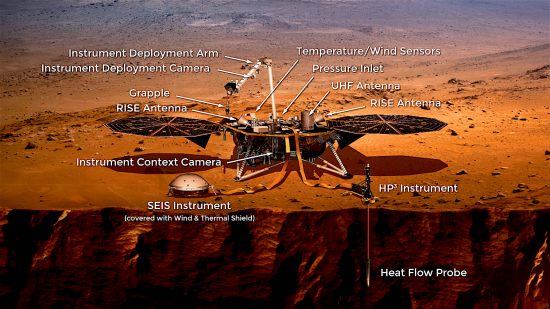Mar 5, 2018
A new mission to Mars.
Sometime in the morning between May 5 and June 8, 2018 NASA will launch the Mars InSight lander. Unlike the upcoming Mars 2020 rover, this new mission will be sessile, studying Mars only from its landing site.
A key component of the mission will be an attempt at detecting marsquakes for the first time. A seismometer will monitor the Martian surface for ground motion. Planetary scientists believe that Mars shakes when meteors impact the surface, or because of volcanic activity that still exists. Although no evidence for marsquakes exists, InSight will look for seismic waves propagating through Mars.
NASA mission team members are operating under the assumption that Mars evolved over billions of years in a unchanging clockwork Solar System. No catastrophic events are allowed, except for the occasional large asteroid, and those are thought to be so rare that they happen over thousands or millions of years. What the mission wants to know is why Earth and Mars are so different; presuming that they both arose from the same nebular cloud. Ignoring electricity in space means that variability in planets is mysterious.
Insight will also make use of new CubeSat technology. Onboard the launch vehicle will be two “briefcase-sized” devices that will act as relay stations for the mission. They will follow the lander down and transmit data from the initial touchdown. This will be a test of this technology, so InSight will be able to communicate with Earth even if the CubeSats fail.
The atmosphere on Mars averages 75 degrees colder, with an average atmospheric density that is 0.6% that of Earth. It is the equivalent to standing on a mountain 35 kilometers high. It is also dry, with only some suggestions of water ice. InSight is also a water hunter, since without water in the form of subsurface ice, the chances of finding life on Mars are slim.
InSight will land in the Elysium Planitia region, about 600 kilometers from where Curiosity is exploring Mount Sharp in Gale Crater. The landing area was chosen from among 22 candidate sites for safety: a flat surface with no large boulders, slopes, cracks or depressions. This is because the platform must remain stable and be able to use its solar panels effectively.
Previous Picture of the Day articles argue that if the environment on Mars was ever one of flowing water and a dense atmosphere, those conditions were completely altered by planet-wide electrical discharges. Water or life forms were obliterated by lightning bolts from a charged object in proximity to Mars. Whatever that object was, it also initiated underground currents of electricity, blasting out gigantic chasms in the Martian surface. The X-ray and gamma-ray emissions, thermal energy and explosive shockwaves from such occurrences would be sufficient to irradiate any organism.
Layering in Elysium Planitia, and elsewhere, was most likely due to ionic wind deposition and not to rainfall, flooding, or melting ice. Although the Mars Reconnaissance Orbiter (MRO) found what were said to be giant glaciers under mountainous piles of rocks and dirt near the Hellas Basin region, that data is open to other interpretations. There are factors on Mars that are so unlike those on Earth that MRO’s radar could be acting in ways that were unanticipated. Ice may only appear to be the nearest match. Since planetary catastrophes were so all-consuming, it can be generally assumed that no life will be found on Mars.
Stephen Smith













